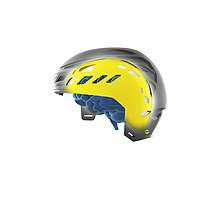Multi-directional Impact Protection System
MIPS BPS (Brain Protection System) is a safety technology for helmets. In the event of an angled impact MIPS can reduce harmful rotational forces, which may be transmitted to the brain, by allowing the helmet to slide relative to the head. These rotational forces can cause concussions or even worse brain damage. MIPS stands for Multi-directional Impact Protection System.[1]
The technology was developed by specialists at the Royal Institute of Technology (KTH) and a brain surgeon at the Karolinska Institute in Stockholm, Sweden, in 1996.[2]

Rotational motion
To understand the functionality behind MIPS BPS, it is important to know what rotational motion is, and why it is so harmful to the brain. Rotational motion, in this case, is the result of the brain continuing to move or stretch after the head has come to a quick and sudden stop following an angled impact. Several researchers have linked severe brain injuries like Diffuse Axonal Injury (DAI) and Subdural Hematoma (SDH) to the transmission of rotational motion to the brain from angled impacts. Mild Traumatic Brain Injury (MTBI) or concussion is also believed to be caused by rotational motion.[3]
Functionality
In a helmet equipped with the MIPS technology, a low-friction layer allows the helmet to slide relative to the head, resulting in a reduction of the rotational motion that may otherwise be transmitted to the brain. In this way, the MIPS approach mimics the natural safety system of the human head.[4] The brain is surrounded by cerebrospinal fluid that protects it by allowing the brain to slide inside the skull when exposed to an angled impact. Mimicking the cerebrospinal fluid, MIPS adds a low friction layer that enables a relative movement of 10–15 mm between the head and the helmet in any direction.[3]
The MIPS BPS is integrated by the manufacturer. It cannot be retrofitted by the consumer.[5]
History
In 1996, Swedish neurosurgeon Hans von Holst began evaluating the general construction of helmets. Following several years of study and work related to head trauma for the World Health Organization in Geneva, he determined that existing helmet technology provided inadequate protection against brain trauma, often with devastating consequences for the victims of brain injuries.
Together with Royal Institute of Technology researcher Peter Halldin, von Holst developed a technology that was designed to provide a more effective protection against brain trauma.[2] To evaluate the risk of different types of head injuries and to simulate impacts were a person is wearing a helmet, they used the Finite Element Model (FE Model), developed by Svein Klein, Professor at Sweden’s Royal Institute of Technology (KTH).[6] After thoroughly evaluating the brain anatomy, physiology, and combining their years of testing and expertise, von Holst and Halldin produced what is now known as the MIPS Brain Protection System, a technology that mimics the brain’s own protective structure.[2]
- The company MIPS AB was founded in 2001 by five specialists in biomechanics of the Royal Institute of Technology (KTH) in Stockholm, Sweden.
- Following its inception in 2001, MIPS AB evolved from concept to product, introducing the technology in an equestrian helmet 2007. At that time MIPS had their own helmet model but they changed their business model to be an ingredient brand, offering their product to existing helmet brands. As MIPS grew internationally, it debuted the now instantly recognisable ‘Yellow Dot’ branding in 2009, giving the Stockholm-based company a clear and distinct identity in logo and across all online platforms.
- In 2010, MIPS AB expanded into the bike and snow helmet industries, gaining widespread acceptance as both the technology, and awareness of head trauma became increasingly recognised in similarly risky sports.
- In early 2014, one of the world’s largest helmet manufacturers, BRG Sports, Inc. and MIPS AB entered into a formal partnership after several years of sharing their technology, offering MIPS’ technology to a much wider global audience. Since then, MIPS AB has added several new brands to its catalog and has expanded to the American, European and Chinese markets.
- Towards the end of 2015, MIPS made its millionth layer, and by the end of 2019, it had produced 14.2 million layers across 583 different helmet models from 103 helmet brands.
- Another big step in the history of MIPS occurred in 2017, when the company was listed on the Nasdaq Stock Market, attracting more than 3,000 shareholders at the time. Today, MIPS has over 7,500 shareholders.
- In 2019, the founders Peter Halldin, Hans von Holst and Svein Kleiven received the prestigious Polhem Prize, the oldest and most prestigious technical Swedish award.[7]
- In the beginning of 2020, MIPS have produced more than 14.2 million layers, are working with 103 brands and there are 583 helmet models that have MIPS BPS inside.
References
- "Road.cc/all you need to know about MIPS". Road.cc. Retrieved 2020-04-21.
- "Innovation — MIPS History". mipsprotection.com. Retrieved 2020-03-02.
- "MIPS". sweetprotection.com. Retrieved 2020-03-02.
- Mark Sutton (2019-12-19). "The scientific case for helmet safety: data, accuracy, and what we can measure". cyclingindustry.news. Retrieved 2020-04-23.
- "Frequently Asked Questions about MIPS helmet safety". mipsprotection.com. Retrieved 2020-03-02.
- "Innovation — FE Model". mipsprotection.com. Retrieved 2020-03-02.
- "MIPS Protection/How MIPS works". mipsprotection.com. Retrieved 2020-03-01.